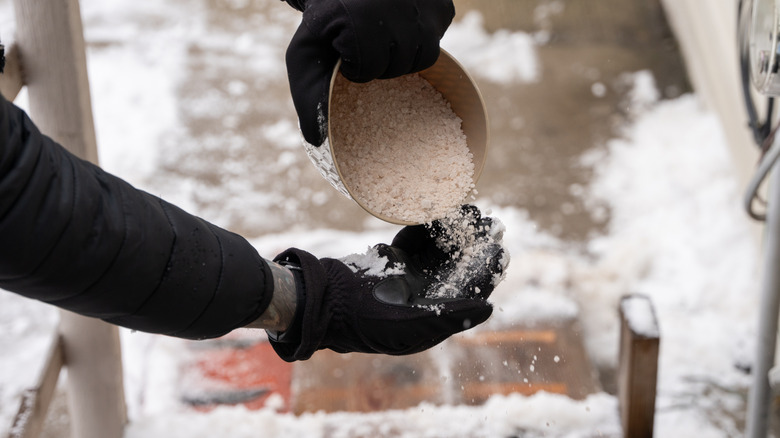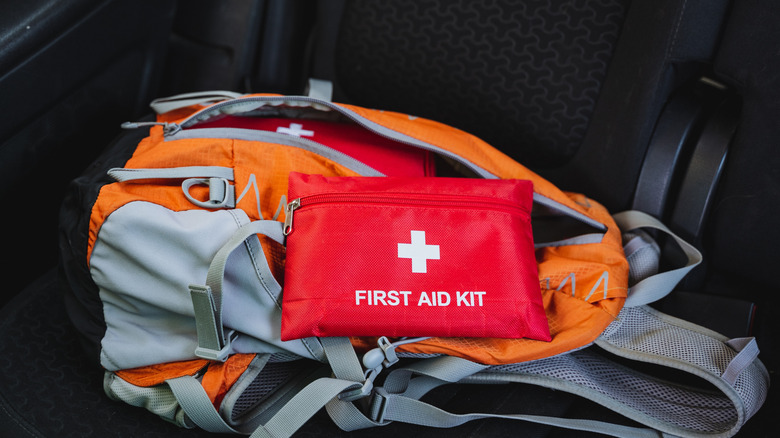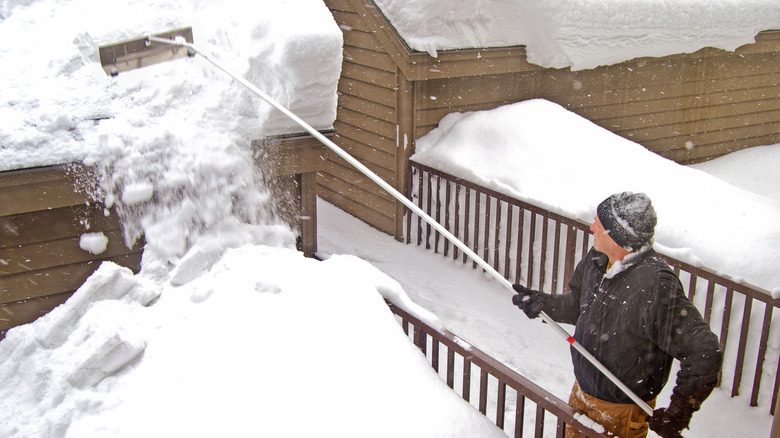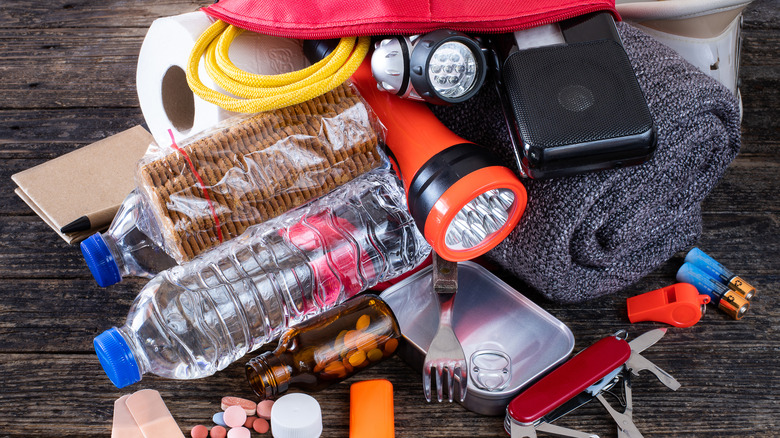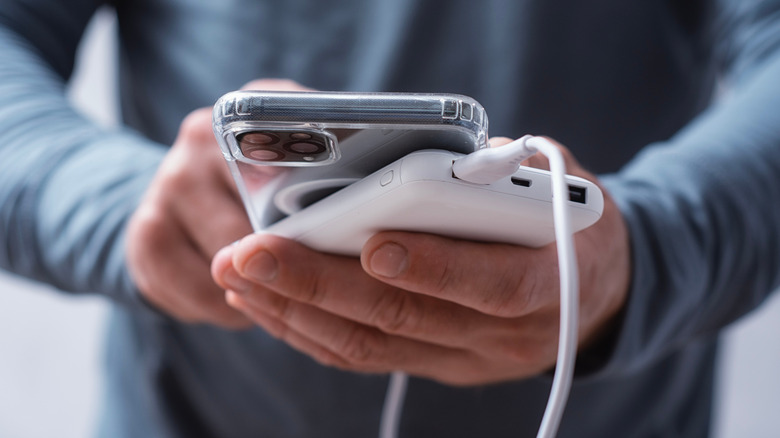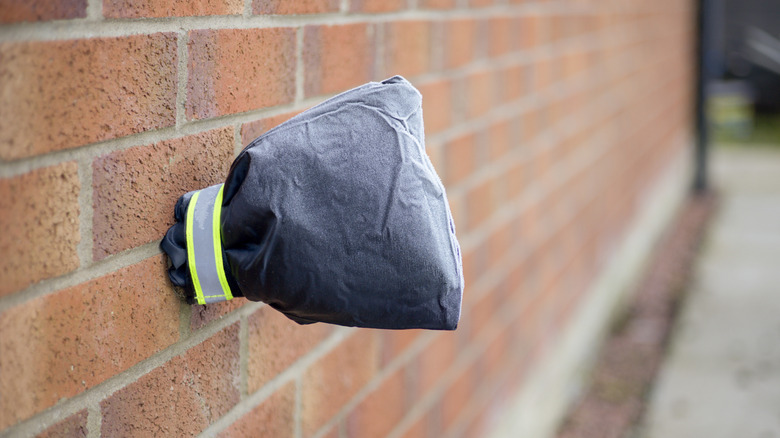13 Winter Tools & Essentials To Have On Hand Before Snowy Weather Hits
We may receive a commission on purchases made from links.
Nobody wants to give up the perfect fall days, with ideal temperatures, cool breezes, and gorgeous leaves. But you can't stop the chill of winter from coming, and you don't want to get caught without the essentials. The last thing you want to do during the first snowstorm is fight all the other procrastinators for the last good shovel and bag of ice melt. Plus, it's dangerous to make multiple trips to the store for essentials once the snow starts and the roads get slick. That's why we've put together a list of 13 winter tools and essentials, from emergency lighting and first-aid kits to snowblowers and car scrapers.
Of course, your situation may vary, so you might not need every item to prep your home for cold weather. If you live in a condo with snow removal included, you won't need a snow blower or ice melt, for instance. And if you're a city dweller without a vehicle, you can skip the car scraper and car emergency kit. We're covering the basics with details on how each item is helpful, so you can decide for yourself what you need to add to your collection. Before you head out to buy items on the list, check your current inventory, and inspect the condition of items you have to decide if it's time for a replacement.
A durable snow shovel
A sturdy snow shovel is an essential for clearing snow, particularly in smaller areas that require precision. Shovels work best on lighter snow, as heavier snow in larger amounts is best dealt with by a snowblower, but you'll still want a shovel for tight areas or quick jobs. Almost everyone benefits from having a snow shovel, even if your HOA and/or city handles snow removal, since it'll allow you to clear your driveway on your schedule. If you have no use for a shovel at home, it's still useful to have a small snow shovel in your car to clear drifts away from your tires if you get stuck.
Knowing how to choose the perfect snow shovel that meets all your needs can seem overwhelming. It helps to shop in person, so you can make sure the shovel is long enough that you don't strain yourself, yet short enough to handle properly. Ergonomic shovels, including those with extra assist handles, can make shoveling easier while reducing strain.
When it comes to the blade, a rounded scoop style lets you lift and toss snow or push it aside, while a flat blade helps you cut through deeper snow. Plastic versus metal is another consideration: Plastic shovels are typically lighter and less likely to have snow stick to them, but they are less durable, especially if they're thin. Metal shovels are more durable, but they're often heavier to lift.
A snow blower
Not all homeowners need a snow blower, but you may want one if you have a large area to clear, live in an area with heavy snowfalls, or have limited mobility that makes shoveling challenging. Snow blowers speed up the process and require less effort than shoveling, which makes them handy for early-morning snow clearing before you have to go to work. Snow blowing can cut down on the risk of strains and back injuries that come with shoveling, but there are still risks from the physical exertion the machines require, so it's important to heed any and all safety guidelines when using a snow blower.
When buying a snow blower, a one-stage machine will likely be cheaper, but it's best for lighter snow only. For heavier snow, you'll want a two-stage snow blower, which has powered wheels and an impeller fan to help push the snow out of the chute. While larger models with more stages are more powerful, they also tend to be wider, which can make them difficult to store. Regarding power source, corded models tend to be less powerful than gas-powered blowers, and since you're tethered to a cord, they aren't ideal for large properties. If you don't want a gas model, battery-powered snow blowers are available.
A salt spreader and ice melt
If you live in an area with snow, you're likely having to deal with slippery sidewalks and driveways. Products such as salt — although some include other ingredients — can help melt ice and add grip to those slippery areas, reducing the risk of falling. Stocking up on these products before the first snowfall can keep your family (and your neighbors who walk on your sidewalks) safer.
You can pour or toss ice melt out by hand, but using a spreader makes it more consistent. Handheld options, like the Chapin shaker spreader, are affordable, lightweight, and small enough to easily store. Alternatively, you can use a push broadcast spreader to distribute ice melt over larger areas. When it comes to the actual ice melt, consider the chemicals used in the products. Homeowners traditionally use rock salt ice-melt products to help clear driveways and sidewalks, but many homeowners are ditching salt for calcium chloride, magnesium chloride, or calcium magnesium acetate, all of which are safer ice-melt options since rock salt can harm plants and even the wildlife in nearby bodies of water. Simply read the labels on ice-melt products to determine which ingredients are being used.
A sidewalk ice scraper
There are many handy hacks to take care of snow and ice outside, but an ice scraper is a simple tool that can help big time. Shovels and snow blowers do a good job of removing snow, but packed-down precipitation or sheets of ice left behind by winter storms aren't easy to remove. Ice-melt products can help somewhat, but they often aren't effective on thicker ice and can get expensive if you have a long, icy winter. A specialty ice scraper tool designed for sidewalks and driveways, like the Snow Joe ice chopper, features a heavy-duty metal blade shaped to break up the ice. While the handle is long, the tool itself is relatively slim, so it can tuck easily into a corner of your garage.
Before buying an ice scraper, check its handle length to make sure you can use the tool properly; you need good leverage to chop, pry, and break up the ice. Fiberglass handles are lightweight and absorb more shock impact than metal handles, although a metal-handled ice scraper is often more durable. Once you find an ice scraper that works well for you, pair it up with ice melt to soften the ice before using the scraper.
A car scraper and brush
Car owners in snowy climates can't live without a sturdy ice scraper for their vehicle. After all, it's a matter of safety to make sure you can thoroughly clear your windows. Even if you have a garage at home, you can't guarantee you'll have covered parking when you're out. Snowy weather while you're at work, at the store, or even on a road trip can quickly cover your windows, and the last thing you want to do is wait for your defroster to melt it all before you take off.
A combination option with an ice scraper along with a snow brush or broom is ideal, as it works on all types of winter weather. If you can, test the grip when shopping for ice scrapers: a padded, ergonomic design is ideal if you live in a cold climate with lots of winter precipitation. Also, consider the handle length, especially if you have a larger vehicle. Some models have an extending handle that makes it easier to store while still letting you reach the middle of your windshield. Make sure the scraper is made of thick, durable plastic, and if you choose a model with a brush, you want the bristles to be tough enough to move the snow yet gentle to avoid damaging your vehicle.
A cold-weather emergency kit for each vehicle
Another must-have for winter driving conditions is a fully stocked car emergency kit. Snowy, icy conditions increase the risk of accidents, and black ice can sneak up on you even if you think the roads are clear. Accidents aren't the only concern, as your car could suffer mechanical failure or you could get stuck in deep snow on the road. Having emergency supplies in your vehicle helps you stay warm and safe until help arrives, and, in some cases, can assist in summoning help.
You can start with a premade kit, like this Lianxin roadside assistance emergency kit, which often includes jumper cables, basic tools, emergency blankets, and tow ropes. Make sure you have the tools needed to change a tire, too, and from there, add what you need based on your climate. It's always a good idea to keep extra hats, gloves, blankets, and other warm items in your car in case you're stranded with no heat, and a first-aid kit is a must. Flashlights or lanterns help you get a better look at car damage or under the hood, and flares or hazard lights warn others about your location. It also helps to keep a small shovel and kitty litter (or another material to give you traction) in case you get stuck.
A telescoping roof rake
If you live in an area with cold temperatures and frequent snowfall, you could be at risk of an ice dam, an often-damaging situation caused by poorly insulated attics. If enough warm air from your home rises into the attic, the bottom layer of snow on the roof can melt and refreeze near the eaves, where the roof is colder. It can eventually force melted snow to move under the shingles and into the house. Instead of leaving the snow to melt and refreeze, grab a roof rake and pull it off the roof.
Look for a roof rake with an extendable handle, which can range from a few feet up to 30 feet. Longer handles let you reach more of the roof while keeping your feet firmly on the ground, making it a safe way to clear snow from a roof. This tool comes in different shapes and materials. A standard roof rake has a blade that moves snow off the roof; look for a model with rounded edges to minimize the risk of roof damage. Some models also have an Oxford slide attached, which looks like a little tarp attached to the rake end and makes it easier for the snow to slide down.
Emergency lighting sources for home and vehicles
Every home should have flashlights or lanterns available for unexpected power outages, which in the winter can happen due to the weight of ice and snow on power lines, as well as branches that fall on them. Strong winter winds are often detrimental to the lines, and just cold temperatures alone can cause outages if customer demand for heating items exceeds what utility companies can handle. The last thing you want to do is sit in the dark or drain your phone battery to use the flashlight when you don't have power and don't know when it'll come back on.
To prepare for being suddenly plunged into darkness, always keep an assortment of battery-powered light sources on hand, along with extra batteries in all the sizes you need. Rechargeable flashlights and lanterns can cut down on the need to buy more batteries, but you'll need to make sure they're charged. Battery-powered candles can do double-duty as decoration and emergency lighting, while headlamps come in handy for hands-free lighting if you have tasks to perform or activities to enjoy while you wait for the power to return. And if you don't have time to grab an emergency lantern before winter, some genius hacks to know during power outages include fashioning a DIY lantern from a water bottle and your phone light.
Space heaters
Even if your furnace is running just fine, it's often helpful to keep a few space heaters on hand to warm smaller areas, which can help in extreme cold when your furnace struggles to keep your home warm. Space heaters are also useful for preventing one of a homeowner's worst winter nightmares: pipe freezing.
While insulated water pipes typically won't start freezing until the surrounding temperature reaches 20 degrees Fahrenheit, that doesn't mean your entire house needs to get that cold. Colder parts of your house, particularly where pipes run through exterior walls and/or are not reached by your home's furnace, are particularly at risk of freezing. If the temperature drops significantly outdoors, turn on a space heater in those rooms where pipes are most prone to freezing, and opening sink cabinets so the warmth can reach those pipes can also help.
Before you hit the stores, consider how large an area you may need to heat; a couple of common mistakes that people make when shopping for a new space heater are buying the wrong size and ignoring energy efficiency. Electric space heaters typically use either convection heating, which warms the area, or radiant heating, which doesn't warm the air, but rather warms objects in front of it. Choose a convection model if you want to heat the air throughout a space, or a radiant space heater if you want to warm specific spots in a room. Check for built-in safety features, like protection from overheating or a tip-over switch, and might also want convenience features, such as remotes or timers.
A first-aid kit
A first-aid kit is among the emergency supplies that every house should have stocked, and it's a good idea to check yours before winter arrives. Cold, snowy weather can cause a range of injuries, including slips and falls, frostbite, and back injuries, often due to spending too much time outdoors or shoveling snow and ice. Replenishing your first-aid supplies before winter keeps you prepared to treat minor medical issues or help stabilize more serious injuries until first responders arrive.
Premade first-aid kits offer a convenient way to get the basics without forgetting something important, and a wide range of these products is available. For example, the Care Science first-aid kit includes 110 pieces, which should cover most households' basic needs. Meanwhile, the Gevoke professional emergency first-aid kit is much larger, with 500 pieces, including multiple sterilization products and survival tools. If you have unique medical needs, such as diabetes or allergies, you might want to put together your own first-aid kit (or expand on a premade kit).
Solar-powered or portable device chargers
If an ice storm brings down the power lines or the grid goes down due to high heating demands, having backup power sources, such as portable power banks, helps you stay connected during the outage. Your cellphone is often a lifeline to loved ones and emergency services, and you can use it to receive weather and power-restoration updates. If you think batteries could be a limiting factor or don't want to rely on your chargers being precharged, hand-cranked and solar-powered devices are also available, from radios to chargers. Having multiple powering options keeps you covered for a variety of situations.
Consider the types of devices you will need to keep powered and for how long before shopping for power banks, as a range of outlet types, battery capacities, and electrical outputs are available. On the other hand, rechargeable power banks are easy to use, as long as you remember to charge them routinely. If you're considering a solar charging bank, determine whether or not your area gets enough sunlight in winter to keep it powered.
A back-up generator
Worrying about the next winter power outage can be significantly reduced by securing a backup generator for your home, which can power crucial electrical appliances — or even your entire home — until service is restored. People who rely on medical equipment benefit significantly from such a backup power source. Not only will you appreciate the ability to keep your home warm and your fridge-freezer running, generators also come in useful for when spring or summer storms knock out the power.
While we can't cover everything you need to know about getting your first generator, there are some basics to consider first. Portable generators are the least expensive option and don't require any permanent installation, although you'll need to set one up each time you use it and continue refueling it. Standby generators are more suitable if you want something more permanent that switches on automatically if the power goes out, although they are significantly more expensive and usually require professional installation. Whichever option you choose, the size (and cost) will simply depend on how much you want to power with the generator and for how long.
Pipe and faucet covers
One of the most potentially destructive effects of winter weather is pipe freezing, which can cause pipes to burst. How long it takes for the pipes in your home to freeze in cold weather depends on several factors, including the temperature and whether or not the pipes are insulated. For example, insulated pipes might freeze in about six hours if the temperature dips to 20 degrees Fahrenheit, but it could take 12 hours if it's a little warmer. Regardless, there are preventative measures to minimize this risk, including faucet and pipe covers.
Outdoor faucet covers go over your spigot and help trap heat while keeping cold air away from the faucets to prevent pipe freezing. They come in hard-shell and soft versions: rigid models are more durable and protect against impact, but soft covers typically provide more thermal protection for the faucet. Indoors, you can cover your pipes with insulating covers to prevent heat loss and freezing. Foam is a popular material option that's easy to install, cost-effective, and mold-resistant.



